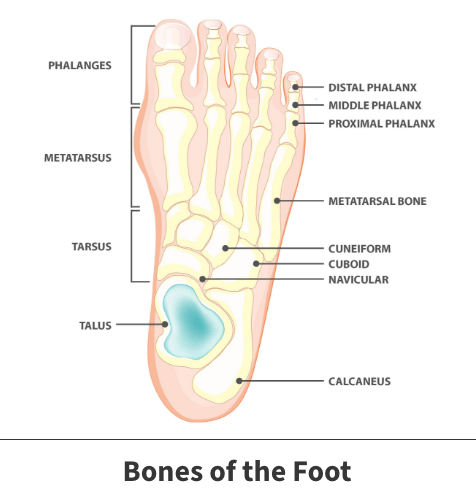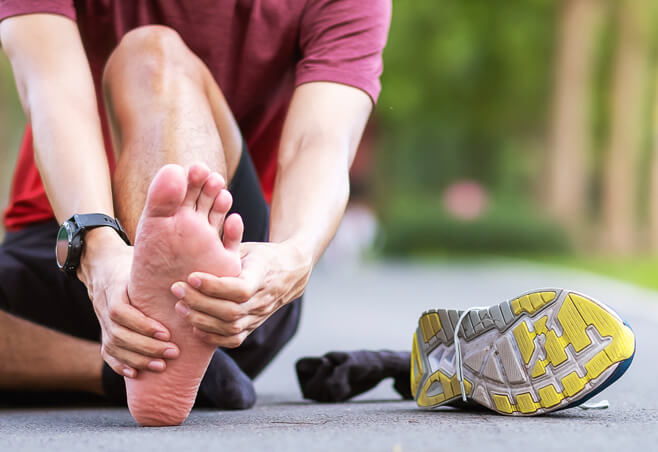Turf toe
When you think of important physical features, you might overlook your toes and feet. However, these body parts enable people to perform basic functions like standing, walking, exercising, and supporting weight.
It should not come as a surprise that many conditions can affect them. One such issue is turf toe.
Anatomy

This injury impacts the big toe. Your big toe contains a large joint called the metatarsophalangeal joint and is abbreviated as the MTP. The MTP attaches the metatarsal foot bone to the toe bone (the phalanx).
Additionally, the MTP is located near other important foot components, including:
- Soft tissues known as the collateral ligaments which connect the foot and toe bones
- A tendon known as the flexor hallucis brevis
- Two small stability-providing bones called the sesamoids
- A thick, cushioning collection of tissue called the plantar plate
Together, these structures form what is medically labeled the plantar complex. When turf toe occurs, any of these features also stand at risk of becoming injured.
What is turf toe?
Though turf toe is often associated with some type of harm being done to the MTP, the term can also refer to injury to any plantar complex feature.
Injuries to these features can range from simple overstretching to complete tears and dislocations. Damage is divided into categories of severity.
- Grade One – This simplest and least severe injury occurs when a member of the planar plate complex is stretched.
- Grade Two – Grade Two events happen when the MTP or another complex member sustains a partial tear.
- Grade Three – These most severe occurrences are the result of complete tears or dislocations.
Causes
Typically, these injuries are most common in athletes. Most cases strike football players. This is because they compete with the forefoot firmly planted on the ground with their heel raised. The problem occurs because this repeated, awkward position places greater pressure on the big toe and often leads to joint dislocation.
These injuries tend to occur on artificial turf surfaces because these fields are usually harder and less forgiving than natural surfaces. This fact led to the condition being named turf toe.
The shoes specially-designed for athletes to compete on artificial turf are less comfortable and harder to move in than those built for natural surfaces like grass.

Symptoms
The number of symptoms and their intensity varies depending on the injury grade. However, common occurrences include:
- Pain at the big toe’s base
- Swelling
- Redness
- A clicking or popping sound when the impacted toe is moved
In more serious cases, you may have trouble moving the toe or bearing weight on the foot. Moreover, mild injuries could worsen if not properly diagnosed and treated.
Diagnosis
During the early stages of examination, a doctor will carefully examine the injured toe and measure the MTP joint’s motion range. If the range is limited, they may bend the toe in several different directions. Moderate to severe tears or dislocations will limit movement or cause more intense discomfort.
If the previous tests do not provide the doctor enough evidence to confirm a diagnosis, the patient may need to undergo diagnostic imaging tests such as X-rays or MRI scans (magnetic resonance imaging).
Treatment
Most cases of turf toe can be treated using nonsurgical methods. Surgical intervention is usually only performed to correct the most severe soft tissue tears or joint dislocations.
Nonsurgical treatments
Most Grade One and Two injuries can be treated using nonsurgical therapies.
The initial treatment for many Grade One events is the R.I.C.E. first aid method. This acronym is short for resting, applying ice, compressing, and elevating the injured toe.
If further treatment is necessary, the use of orthotic devices designed to provide additional cushioning can be inserted into one’s shoes. Occasionally, more significant Grade One events are treated with corticosteroid injections.
Grade Two injuries will likely require a period of immobilization. Items like thick tape or walking boots prevent the damaged joint or soft tissues from moving and sustaining further damage. The immobilization period typically lasts from several days to two full weeks.
In addition to restricted mobility, treatment should also include therapies used to remedy Grade One events.
Grade Three concerns are often immobilized for several weeks inside walking boots or casts. A course of physical therapy might also be needed. These medically-supervised exercises help the toe and surrounding areas regain strength and mobility.
Surgical intervention
The most serious Grade Three incidents usually benefit from surgery. The specific type of operations will be performed to remove injured tissue, repair damaged joints, reposition dislocations, and improve the strength and motion of the MTP and other plantar complex features.
Regardless of the specific operation, surgery will likely be followed by several weeks or months of physical therapy.
Prevention
At-risk athletes like football players may be able to prevent turf toe by engaging in actions, such as taping their big toe before games, placing orthotic devices in their shoes, wearing comfortable, well-fitting footwear, and, whenever possible, training on more foot-friendly surfaces like grass.
Related specialties
- Achilles Calcific Tendinitis
- Achilles Tendon Rupture
- Achilles Tendonitis
- Ankle Fracture Surgery
- Ankle Fractures (Broken Ankle)
- Ankle Fusion Surgery
- Arthroscopic Articular Cartilage Repair
- Arthroscopy of the Ankle
- Bunions
- Charcot Joint
- Common Foot Fractures in Athletes
- Foot Stress Fractures
- Hallux Rigidus Surgery - Cheilectomy
- Hammer Toe
- High Ankle Sprain (Syndesmosis Ligament Injury)
- Intraarticular Calcaneal Fracture
- Lisfranc Injuries
- Mallet, Hammer & Claw Toes
- Metatarsalgia
- Neuromas (Foot)
- Plantar Fasciitis
- Sprained Ankle
- Total Ankle Replacement
